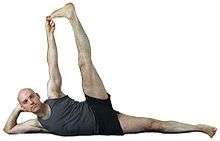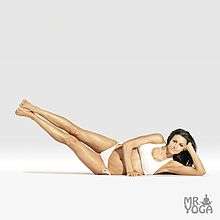Anantāsana
thumb|250px|Anantāsana / अनन्तासन / Posture of Ananta


infinity-pose- variation with both legs lifted and not grabbing onto the big toe
Anantasana (Sanskrit: अनन्तासन; IAST: Anantāsana), Vishnu's Couch Pose,[1] Eternal One's Pose, or Side-Reclining Leg Lift[2] is an asana.
Etymology
The name comes from the Sanskrit words anantā (अनन्त) meaning "without end" or "the infinite one", derived from the name of the thousand-headed serpent Sesa upon which Vishnu rested at the bottom of the primordial ocean,[3] and Asana (आसन, Āsana) meaning "posture" or "seat".[4]
Benefits
Anantāsana involves balance, pelvis, hip, leg adductor muscle, promote blood circulation in the leg muscles.[5]
See also
References
- ↑ "Anantasana". Retrieved 2011-04-09.
- ↑ "Yoga Journal - Side-Reclining Leg Lift". Retrieved 2011-04-09.
- ↑ Iyengar, B. K. S. (1977). Light on yoga: yoga dipika. Schocken Books. p. 246. ISBN 978-0-8052-1031-6. Retrieved 9 April 2011.
- ↑ Sinha, S.C. (1 June 1996). Dictionary of Philosophy. Anmol Publications PVT. LTD. p. 18. ISBN 978-81-7041-293-9. Retrieved 9 April 2011.
- ↑ Kaminoff, Leslie (2007). Yoga Anatomy. Human Kinetics. pp. 160–1. ISBN 978-0-7360-8218-1. Retrieved 9 April 2011.
Further reading
- Iyengar, B. K. S. (1 October 2005). Illustrated Light On Yoga. HarperCollins. ISBN 978-81-7223-606-9. Retrieved 9 April 2011.
- Saraswati, Swami Satyananda (1 August 2003). Asana Pranayama Mudra Bandha. Nesma Books India. ISBN 978-81-86336-14-4. Retrieved 9 April 2011.
- Saraswati, Swami Satyananda (January 2004). A Systematic Course in the Ancient Tantric Techniques of Yoga and Kriya. Nesma Books India. ISBN 978-81-85787-08-4. Retrieved 9 April 2011.
External links
This article is issued from
Wikipedia.
The text is licensed under Creative Commons - Attribution - Sharealike.
Additional terms may apply for the media files.